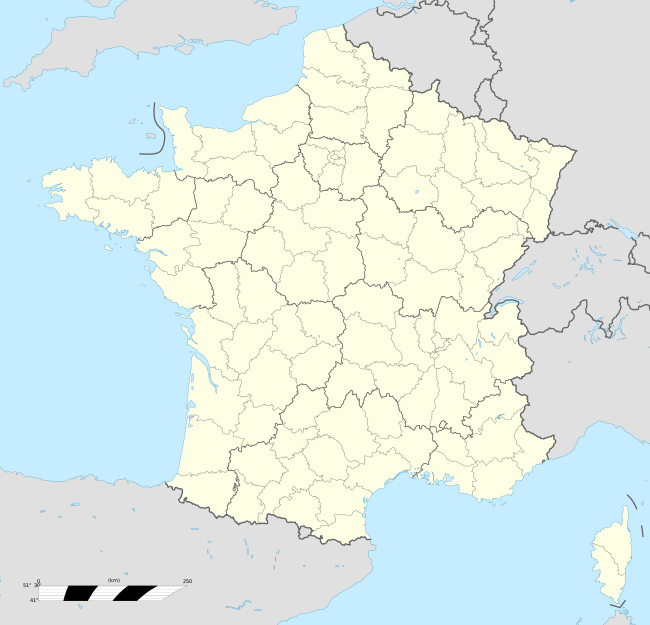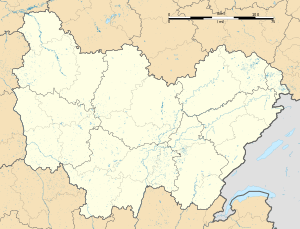Arnay-sous-Vitteaux
Arnay-sous-Vitteaux is a commune in the Côte-d'Or department in the Bourgogne-Franche-Comté region of eastern France.
Arnay-sous-Vitteaux | |
|---|---|
The road into Arnay-sous-Vitteaux | |
Location of Arnay-sous-Vitteaux 
| |
 Arnay-sous-Vitteaux  Arnay-sous-Vitteaux | |
| Coordinates: 47°26′49″N 4°29′54″E | |
| Country | France |
| Region | Bourgogne-Franche-Comté |
| Department | Côte-d'Or |
| Arrondissement | Montbard |
| Canton | Semur-en-Auxois |
| Intercommunality | CC Terres Auxois |
| Government | |
| • Mayor (2014-2020) | Jean François Lallemant |
| Area 1 | 12.14 km2 (4.69 sq mi) |
| Population (2017-01-01)[1] | 111 |
| • Density | 9.1/km2 (24/sq mi) |
| Time zone | UTC+01:00 (CET) |
| • Summer (DST) | UTC+02:00 (CEST) |
| INSEE/Postal code | 21024 /21350 |
| Elevation | 277–482 m (909–1,581 ft) (avg. 235 m or 771 ft) |
| 1 French Land Register data, which excludes lakes, ponds, glaciers > 1 km2 (0.386 sq mi or 247 acres) and river estuaries. | |
The inhabitants of the commune are known as Arnétois or Arnétoises [2]
Geography
Arnay-sous-Vitteaux is located some 50 km north-west of Dijon and 35 km south-east of Montbard. Access to the commune is by the D905 road from Vitteaux in the south passing through the east of the commune and continuing north to Venarey-les-Laumes. Access to the village is by the D1178 from Marigny-le-Cahouët in the north-west passing through the village then north-east to join the D905. There are forests in the west, centre, and east of the commune with the rest being farmland.[3]
The Brenne river passes through the commune from south to north parallel to and west of the D905. The Ruisseau de Chassaigne rises in the south of the commune and flows north through the village to join the Brenne east of the village.[3]
Neighbouring communes and villages[3]
Administration
List of Successive Mayors[4]
| From | To | Name | Party | Position |
|---|---|---|---|---|
| 2001 | 2014 | André Gras | ||
| 2014 | 2020 | Jean François Lallemant |
(Not all data is known)
Demography
In 2009 the commune had 112 inhabitants. The evolution of the number of inhabitants is known from the population censuses conducted in the commune since 1793. From the 21st century, a census of communes with fewer than 10,000 inhabitants is held every five years, unlike larger towns that have a sample survey every year.[Note 1]
| 1793 | 1800 | 1806 | 1821 | 1831 | 1836 | 1841 | 1846 | 1851 |
|---|---|---|---|---|---|---|---|---|
| 344 | 358 | 325 | 385 | 385 | 382 | 365 | 376 | 371 |
| 1856 | 1861 | 1866 | 1872 | 1876 | 1881 | 1886 | 1891 | 1896 |
|---|---|---|---|---|---|---|---|---|
| 300 | 295 | 292 | 293 | 297 | 284 | 277 | 304 | 255 |
| 1901 | 1906 | 1911 | 1921 | 1926 | 1931 | 1936 | 1946 | 1954 |
|---|---|---|---|---|---|---|---|---|
| 241 | 234 | 227 | 195 | 186 | 166 | 151 | 135 | 176 |
| 1962 | 1968 | 1975 | 1982 | 1990 | 1999 | 2006 | 2009 | - |
|---|---|---|---|---|---|---|---|---|
| 208 | 183 | 154 | 170 | 160 | 146 | 133 | 112 | - |

Sites and monuments
- The Fortified house of Arnay.[5]
- The Chapel of Saint Abdon.
- The Parish Church of Saint Alban contains several items that are registered as historical objects:
Gallery of Historical Items
- The Chapel of Abdon in 2012 before restoration
- The original stone altar in the Chapel of Saint Abdon
- A Fragment of a Calvary dated 1502 in the Chapel of Abdon
- An ancient Sarcophagus in the Chapel of Saint Abdon discovered nearby
- The Church of Saint Alban
- The Stained glass window: Virgin and child with donors
- The Monumental Painting: a Bishop and a Consecrational Cross
See also
External links
Notes and references
Notes
- At the beginning of the 21st century, the methods of identification have been modified by Law No. 2002-276 of 27 February 2002 Archived 6 March 2016 at the Wayback Machine, the so-called "law of local democracy" and in particular Title V "census operations" allows, after a transitional period running from 2004 to 2008, the annual publication of the legal population of the different French administrative districts. For communes with a population greater than 10,000 inhabitants, a sample survey is conducted annually, the entire territory of these communes is taken into account at the end of the period of five years. The first "legal population" after 1999 under this new law came into force on 1 January 2009 and was based on the census of 2006.
References
- "Populations légales 2017". INSEE. Retrieved 6 January 2020.
- Inhabitants of Côte-d'Or (in French)
- Google Maps
- List of Mayors of France (in French)
- Élisabeth Sirot, Noble and fortified house - The lordly manors in the medieval countryside from the middle of the 12th century to the beginning of the 16th century, Editions Picard, Paris, 2007, ISBN 978-2-7084-0770-1, LCCN 2007475228, p. 10 (in French)
- Ministry of Culture, Palissy PM21000075 Stained glass window: Virgin and child with donors (in French)
- Ministry of Culture, Palissy IM21000863 Stained glass window: Virgin and child with donors (in French)
- Ministry of Culture, Palissy PM21000074 Statue: Saint Catherine (in French)
- Ministry of Culture, Palissy IM21008599 Monumental Painting: a Bishop and a Consecrational Cross (in French)

- Ministry of Culture, Palissy IM21000864 Stained glass window (in French)
| Wikimedia Commons has media related to Arnay-sous-Vitteaux. |